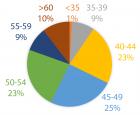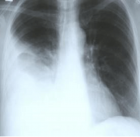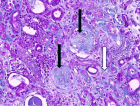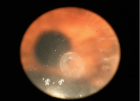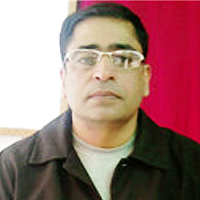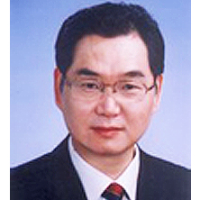Table of Contents
Epidemiological Prevalence of Tuberculosis in the State of Maranhão between 2014 and 2016
Published on: 24th July, 2019
OCLC Number/Unique Identifier: 8207866924
Introduction: Tuberculosis is an infectious disease caused by Mycobacterium tuberculosis (Bacillus of Koch), and presents chronic evolution affecting the lungs frequently.
Objectives: Analyse, in the state of Maranhão, the epidemiological prevalence of tuberculosis between 2014 and 2016.
Materials and Methods: Documentary and descriptive study of secondary data collected in the database of the dates, epidemiological information and morbidities, between 2014 and 2016.
Results: 3,897 cases of tuberculosis in the state of Maranhão were recorded. The most affected age range was 15 to 59 years, totaling 3,111 cases, for both gender; of 60 to 79 years, 577 cases were totaled.
Conclusion: Tuberculosis affects more adolescent males from adolescence to old age, and it is necessary to promote knowledge of the disease for the population in order to advance in the control of the same and obtain satisfactory clinical results.
Eosinophilic otitis media and eosinophilic asthma: Shared pathophysiology and response to anti-IL5
Published on: 4th June, 2019
OCLC Number/Unique Identifier: 8165317458
Asthma is a highly prevalent airway disease with multiple phenotypes [1,2]. Adult-onset eosinophilic asthma is a severe asthma subtype associated with more frequent and severe exacerbations, the development of persistent airflow limitation and a poorer quality of life. This type of asthma is much more difficult to control than other asthma subtypes, requiring high doses of inhaled or even oral corticosteroids (OCS) [3,4]. Recently, several new monoclonal antibody therapies have been approved for eosinophilic severe asthma, including anti-IL-5 treatment. IL-5 is essential for eosinophilic maturation and survival [5] and anti-IL5 treatment has markedly reduced asthma exacerbations with sparing of OCS use in patients with eosinophilic asthma [6]. Eosinophilic asthma is frequently associated with chronic rhinosinusitis and/or nasal polyposis [7], suggesting that a similar eosinophilic inflammatory process might drive both conditions. Eosinophilic otitis media (EOM) also might fit in this concept, showing remarkable similarities with asthma and nasal polyposis. The disease was first reported in 1994, but only since 2011 diagnostic criteria for EOM were identified. If a patient shows otitis media with effusion or chronic otitis media with eosinophil-dominant effusion (major criterion) and is being positive for ≥2 items of the 4 minor criteria (highly viscous middle ear effusion, resistance to conventional treatment, association with asthma, association with nasal polyposis) he is diagnosed as having EOM. Eosinophilic granulomatosis with polyangiitis and hypereosinophilic syndrome must be excluded [8].
Stethoscope - Over 200 years
Published on: 18th January, 2019
With the invention of the stethoscope, in the early 1800s, a better diagnosis of heart and lung disorders was opened up. Through the stethoscope's 200-year history, there has been a significant development of the stethoscopy from the use of the simple monaural earpiece to the binaural stethoscope, followed by the electronic stethoscope, which, together with other studies, has enabled a thorough diagnosis of these disorders. Here is a glimpse of this story.
The cross-border investigation
Far back in time, it has been clear that the function of the heart and lungs played an important role in maintaining life. By tapping with the finger (percussion) and putting the ear to the patient's chest (auscultation), it could hear sound from the body telling about the patient's condition, especially about the presence of fluid or air-filled organs. Auscultation is already described in the Corpus Hippocraticum, in the Diseases II section [1]. The doctor puts the ear to the chest of a patient with water sores, to hear the pain as a wine vinegar from the lungs - or the doctor grabs the patient about the shoulders, shakes him and places his ear to his chest to hear in which side his pleuritis is sitting. Since then, auscultation seems to have been partially forgotten, although it has probably been known by Ambroise Paré and William Harvey [2]. It was not until the late 1700s that it became an important diagnostic aid, just like the pulse clock and the medical thermometer [3 p. 277]. Here, Joseph Leopold Auenbrugger (1722-1809) is considered to be the father of the modern physical examination, which is based on percussion. Percussion he performed by knocking direcly on the thorax with the finger or cupped hands. His discovery of the percussion sounds from the chest during inhaling and exhaling originates from his work in 1760 at the Vienna Military Hospital [4]. In 1761, His little book on thoracic percussion revealing thoracic diseases appeared in 1761 [3p.271], which in 1808 was translated into French by the Parisian physician Jean Nicolas Corvisart des Marets (1755-1821). This contributed to the French doctors starting to use percussion and ausculation more routinely [5].
The limitation of simple auscultation was the fact that the sound was weak and incomplete and therefore there was a need for improved sound quality. In addition, the direct contact with the patient's body could seem insulting

HSPI: We're glad you're here. Please click "create a new Query" if you are a new visitor to our website and need further information from us.
If you are already a member of our network and need to keep track of any developments regarding a question you have already submitted, click "take me to my Query."






